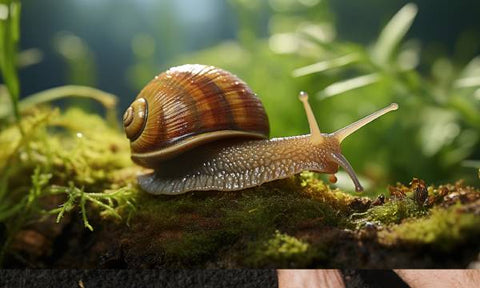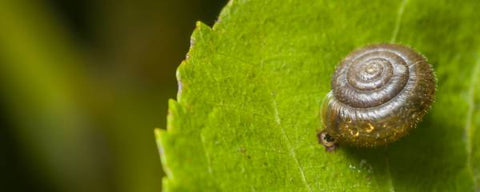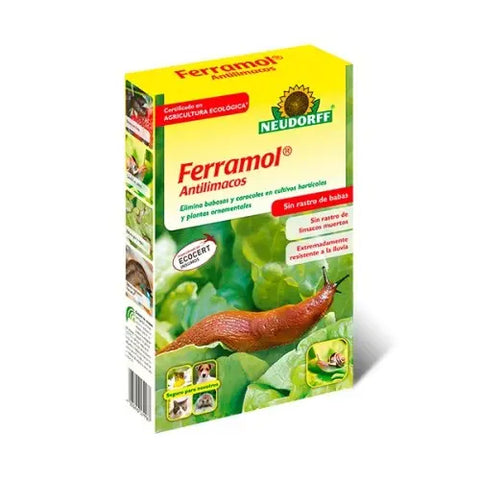
Tabla de contenidos
[HideShow]
- How to Identify Snails in Marijuana Cultivation
- How to prevent snails in cannabis cultivation
- Anti-snail products
- 1. Recommendations for Safe Use in Marijuana Plants
- Organic and Ecological Solutions for the Elimination of Snails in Plants
- 1. Physical Barriers
- 2. Natural Traps
- 3. Organic Repellents
- 4. Companion Cultivation
- 5. Biological Control
- Tips and Best Practices
- Leave a comment
How to remove snails from marijuana plants
In the world of cannabis cultivation, dealing with unwanted invaders is a constant battle. Pests and diseases in marijuana are very common and one of the most common and frustrating problems for growers are snails and slugs. These small but voracious mollusks can be a big headache, especially when it comes to protecting the health and vitality of marijuana plants.
Snails and slugs, attracted to moisture and organic matter, find cannabis plants a perfect feast. Not only do they munch on leaves and stems, but they also leave behind a trail of slime, compromising the aesthetics and health of the plants. Understanding how to remove snails from plants and how to effectively remove slugs is crucial to ensuring our precious cannabis plants not only survive but thrive.
Addressing this problem is not just a matter of aesthetics; it is vital for the quality and production of plants. A snail infestation can significantly reduce plant growth and production, affecting the final yield. Therefore, it is essential to adopt effective strategies to eliminate snails from marijuana plants.

How to Identify Snails in Marijuana Cultivation
Identifying the presence of snails on your marijuana plants is the first crucial step in protecting your crop. These mollusks are known for leaving visible traces that give them away. Look for signs such as chewed leaves, especially on the edges, and damaged stems. Another clear indicator is the pressure of shiny, silvery slime on the leaves and soil, which are traces left by snails and slugs as they move. These traces are particularly visible in the morning or after a rain.
Snails are attracted to cannabis plants for several reasons. Firstly, young, tender cannabis plants are especially palatable to them due to their soft texture and high water content. Furthermore, the moist, shaded environment often found in cannabis gardens is ideal for snails, who prefer these conditions for living and reproducing.
The damage caused by snails to marijuana plants can be quite significant. Beyond the obvious physical injuries to leaves and stems, their feeding activity can stress plants, stunt their growth, and decrease their ability to flower properly. In severe cases, a snail infestation can even lead to the death of the plant. Therefore, identifying and responding quickly to the presence of snails is critical to ensuring the health and success of your marijuana crop.

How to prevent snails in cannabis cultivation
Preventing snails from appearing in your cannabis crop is much more effective than treating an existing infestation. Here are some strategies and tips on cultivation and environmental care that can help discourage the presence of these mollusks:
- Regular Garden Maintenance : Keep your growing area clean and tidy. Remove dead leaves, debris and any material that could serve as a refuge for snails. A well-maintained growing area is less attractive to them.
- Humidity Control : Snails love humid environments. Regulate the humidity in your garden by avoiding overwatering and making sure the soil has good drainage. This is not only good for preventing snails but also for the overall health of your marijuana plants.
- Physical Barriers : Create barriers around your plants that are difficult for snails to cross. Materials such as ash, diatomaceous earth, lime or even copper can be effective. For example, a copper band around pots or the growing area can be an effective barrier, as snails avoid crossing this metal.
- Elevated Growing : Consider using raised grow tables or hanging planters. By elevating plants off the ground, you make them less accessible to snails.
- Growing Companions and Biodiversity : Some plants, such as garlic or certain aromatic herbs, can act as natural snail repellents on plants. Integrating these plants into your garden can help keep snails at bay. Additionally, encouraging biodiversity in your garden can attract natural predators of snails, such as birds or beneficial insects.
- Lighting : Snails are primarily nocturnal. Consider using soft lighting at night to discourage their activity.
- Regular Monitoring : Conduct regular inspections, preferably early in the morning or after rain, to detect early signs of snails. The sooner you identify a potential problem, the easier it will be to manage.
Anti-snail products
Among the commercial products available to combat snails in marijuana crops, a prominent one found on Growindustry is:
- Ferramol Anti-Slug Bait : This product is specifically designed to combat snails and slugs. Ferramol anti-slug acts as an attractive bait that, once consumed by snails, prevents them from feeding further, leading them to retreat underground where they die without leaving visible traces of mucus.
- ProNeem Neem Seed Cake : For added plant protection, you can use Proneem Neem Cake. A completely biological insecticide that can be used as a preventative method until the end of the harvest.
Recommendations for Safe Use in Marijuana Plants
- Careful Application : Make sure to apply the product strictly following the manufacturer's instructions. This ensures its effectiveness and minimizes any potential risk to the plants.
- Avoid Direct Contact with Plants : When applying any commercial product, it is crucial to avoid direct contact with marijuana plants to prevent any possible toxicity or residue on the flowers.
- Environmental Considerations : Although Ferramol® Antilimacos is a more environmentally friendly product compared to other chemical pesticides, it is still important to consider the environmental impact and use it responsibly.
- Monitoring and Evaluation : After applying the product, monitor your plants and the surrounding area to evaluate the effectiveness of the treatment and detect possible side effects.

Organic and Ecological Solutions for the Elimination of Snails in Plants
How to get rid of slugs organically and ecologically is essential to maintaining the integrity and purity of cannabis. These methods are safe for both plants and the environment. Here is a detailed list of these solutions:
Physical Barriers
- Wood Ash : Wood ash is an excellent repellent due to its dry, alkaline nature. Spread it around the bases of your cannabis plants, creating a barrier that snails won't want to cross. It's important to replenish the ash after every rain, as it washes away easily.
- Diatomaceous Earth : This fine powder, made from algae fossils, acts as an abrasive and desiccating agent for snails. By spreading it around your plants, you'll create a barrier that physically damages and dehydrates snails as they try to cross it. Make sure to use food-grade diatomaceous earth and reapply after rain.
- Copper : Copper bands create a mild electrical reaction on contact with snails, deterring them from crossing. Place these bands around pots or grow beds. Make sure the bands are wide enough and check periodically to keep them free of dirt that can decrease their effectiveness.
Natural Traps
- Beer Traps : Use shallow containers, such as cans or yogurt cups, and bury them at ground level. Fill them with beer, which will attract snails due to fermentation. Snails will fall into the trap and drown. Empty and refill traps regularly.
- Boards or tiles : Place these flat structures near your plants. During the day, snails will seek shelter under them. You can collect and move snails away from your garden regularly.
Organic Repellents
- Garlic Extract : Prepare a solution with crushed garlic and water. Spray your plants with this mixture, which acts as a natural repellent due to the smell and taste of garlic. It is important to reapply after rain or watering.
- Nettle Puree : Nettles, once crushed and mixed with water, can be sprayed on plants. This method not only repels snails, but can also act as a natural fertilizer for your plants.
Companion Cultivation
Repellent Plants : Growing garlic, sage, rosemary, or thyme near your cannabis plants can be effective in repelling snails. These herbs emit odors that are unpleasant to snails and therefore deter them from approaching your plants.
Biological Control
Nematodes : These tiny parasitic worms are effective against snail larvae. Applied to the soil, they seek out and destroy these pests from within. They are safe for plants and do not harm the garden ecosystem.
Using these organic and eco-friendly solutions is essential to maintaining a healthy growing environment. Not only are you protecting your cannabis plants from snail damage, but you are also preserving the biodiversity and sustainability of your garden, ensuring that the end product is of the highest quality and purity. Being environmentally friendly and non-toxic, these methods are ideal for any grower looking to maintain an organic and eco-friendly approach to their garden.
Tips and Best Practices
For integrated pest management in your cannabis garden, consider these tips and practices:
- Continuous Monitoring : Conduct regular inspections of your plants to detect any signs of pests or diseases early. Early detection is key to effective management.
- Plant Diversification : Growing a variety of plants can help prevent the spread of specific pests. Plant diversity attracts a wider range of beneficial insects and birds that act as natural pest controllers.
- Biological Control : Uses natural predators and beneficial organisms such as ladybugs, parasitic wasps and nematodes to control pest populations naturally.
- Healthy Growing Practices : Make sure your cannabis plants have optimal light, water, and nutrient conditions. Healthy plants are less susceptible to pests and diseases.
- Responsible Use of Pesticides : When it is necessary to use chemicals, choose less harmful options and apply them responsibly to minimize their environmental impact.
- Crop Rotation and Companion Planting : Crop rotation and companion planting can help reduce pest problems and improve overall soil health.
- Waste Management and Composting : Proper management of organic waste and effective composting can reduce pest attraction and enrich the soil.
- Continuing Education : Stay informed on sustainable cannabis cultivation practices and integrated pest management to stay up to date with the best strategies and techniques.

Leave a comment